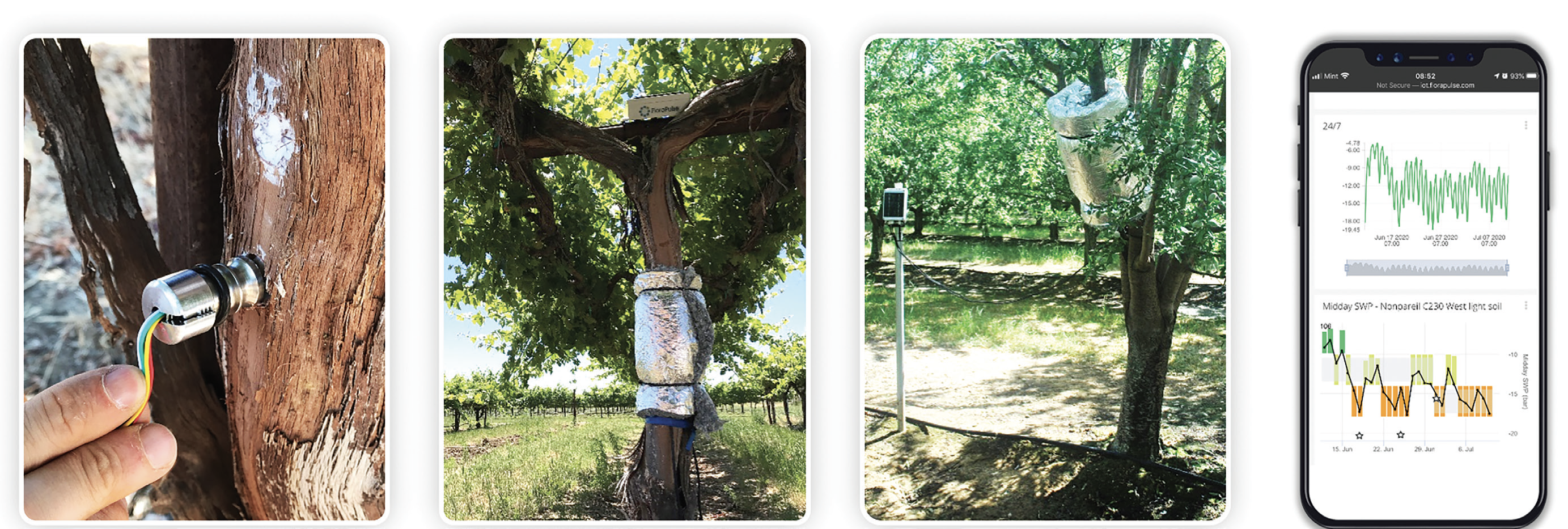
Nov 5, 2021
FloraPulse system measures water potential of trees, vines
When it comes to precision irrigation in orchards and vineyards, you could say that FloraPulse is an inside job.
An electronic sensor embedded in the woody tissue of a plant picked to represent others in the orchard or vineyard measures the plant’s water potential. The sensor, a microtensiometer, is wired to a data logger box that uses a cell phone signal to put the numbers at the grower’s fingertips.
A few hundred of FloraPulse’s systems today are in the hands of scientists and advanced growers internationally and across the U.S.

“The overall picture is that growers need to know when plants are thirsty,” said Michael Santiago, who founded the company with Cornell University professors Alan Lakso and Abraham Stroock. The task is a bit easier in vegetable crops than in fruit and nut trees, where the roots are drawing water from so deep underground that it’s difficult to measure the moisture of the soil itself. And professional growers can’t afford to fall behind on watering.
“If you wait until the leaves are drooping it’s already too late,” Santiago said. “You’re stressing the tree and losing crop.”
Although the manual pressure system remains in use, “people have been looking for replacements since it was invented,” Santiago said. He called the 50-year-old manual pressure chamber system a “painful” system because it involves a person driving the heavy chamber out into the middle of the orchard and running the test there during the hottest part of the day.
While several newer technologies are in different stages of development, FloraPulse seems to be gaining some traction with collaborations with the National Science Foundation, University of California, Davis, researcher Isaya Kisekka, the Abraham Stroock group at Cornell and California Almond Packers & Exporters (CAPEX).
“Everyone benefits,” Santiago said. Researchers use them to study plants’ performance, and for growers, the data is especially of use in California where repeated droughts and regulations brought by the Sustainable Groundwater Management Act, aka SGMA, have increased the necessity of water conservation.
FloraPulse has been more than a decade in the making. Cornell’s Lasko, who had experience using manual pressure chamber systems, began working with Stroock at the university in 2007. Santiago joined as Stroock’s Ph.D. student in 2012. The group built a few early prototypes that generated interest in the industry, driving the effort to privatization. Florapulse was incorporated in 2016, and the company started running full-time in 2017. Although the effort began on the East Coast, today the company is based in Davis, California. The project has been self-funded.
Santiago said it was always understood development was a long road with many challenges – for instance, trees typically have a “wounding” response to embedded technology – but the technology for better data on tree water potential has remained highly sought-after by the industry.
“If we didn’t do it, nobody else would do it,” he said. “It’s kind of a nascent technology.” In recent years, FloraPulse’s systems have been tested, validated and written up in scientific journals, he said.
To use the technology, growers need a cellphone signal of some kind out in their orchards. Growers are encouraged to pick a tree that best represents what’s going on in the orchard.
“Growers right now, they really lack the information,” Santiago said. “So, even one tree can make a huge difference.”
Although the technology has been used with everything from apple to citrus, stone fruit and olive trees, Santiago said California almond and winegrapes growers especially are “very aware of the value of the data.”
“(CAPEX) trialed our product out last year,” he said. “They really wanted to work with us again. The drought is really hurting them.”
Above, FloraPulse probes installed in the trunk of a fruit tree or grapevine are wired to a nearby data logger box that uses a cellphone signal. Growers can access the data remotely. Photos: FloraPulse






